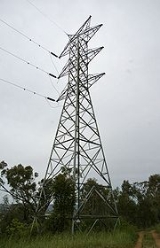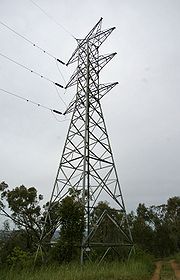
Electricity Commission of New South Wales
Encyclopedia

New South Wales
New South Wales is a state of :Australia, located in the east of the country. It is bordered by Queensland, Victoria and South Australia to the north, south and west respectively. To the east, the state is bordered by the Tasman Sea, which forms part of the Pacific Ocean. New South Wales...
, Australia
Australia
Australia , officially the Commonwealth of Australia, is a country in the Southern Hemisphere comprising the mainland of the Australian continent, the island of Tasmania, and numerous smaller islands in the Indian and Pacific Oceans. It is the world's sixth-largest country by total area...
. The Commission was established on 22 May 1950 by the Electricity Commission Act 1950 and its role was to take over power generation responsibility from the County Councils (such as the Sydney County Council
Sydney County Council
The Sydney County Council was the authority responsible for electricity supplies in Sydney, Australia. The entity was created in 1936, and was elected and controlled by the municipal councils of Sydney. Between 1936 and 1952, it was responsible for electricity generation and distribution...
) and the railways, who until that time were responsible for power generation and distribution. It acquired the power stations and main transmission lines of the four major supply authorities (Southern Electricity Supply, Sydney County Council
Sydney County Council
The Sydney County Council was the authority responsible for electricity supplies in Sydney, Australia. The entity was created in 1936, and was elected and controlled by the municipal councils of Sydney. Between 1936 and 1952, it was responsible for electricity generation and distribution...
, the Department of Railways
New South Wales Government Railways
The New South Wales Government Railways was the government department that operated the New South Wales Government's railways until the establishment of the Public Transport Commission in 1972. Although later known officially as the Department of Railways, New South Wales, it was still generally...
and the Electric Light and Power Supply Corporation Ltd, known as the Balmain Company). The commission was responsible for the centralised co-ordination of the state's electricity generation and supply.
Upgrading and Expansion of power station network
Between 1950 and 1960, the commission more than tripled power capacity, from 490 megawatts to 1800. At first, this involved completing the expansions of BunnerongBunnerong Power Station, New South Wales
Bunnerong Power Station is a demolished former coal-powered electric power station in the south-eastern Sydney suburb of Matraville, New South Wales, Australia. When the last generating units were commissioned, it was the largest power station in New South Wales, with a capacity of 375 MW. It was...
, White Bay
White Bay Power Station, New South Wales
The White Bay Power Station is a heritage listed former coal-fired power station on a site in White Bay, in the suburb of Rozelle, from Sydney in New South Wales, Australia....
, Balmain
Balmain Power Station, New South Wales
The Balmain Power Station was located at Iron Cove, from Sydney in New South Wales, Australia. The station no longer exists and residential properties now occupy the site...
, and Pyrmont, and completing new stations already designed by the Department of Railways: Tallawarra
Tallawarra Power Station, New South Wales
Tallawarra Power Station is a 435 MW combined cycle natural gas power station in the city of Wollongong, New South Wales, Australia. Owned and operated by TRUenergy, the station is the first of its type in New South Wales and produces electricity for the state during periods of high demand...
near Port Kembla (1954), Wangi
Wangi Power Station, New South Wales
Wangi Power Station is located in Wangi Wangi, New South Wales on Lake Macquarie. The power station operated between 1956 and 1986 and supplied New South Wales with electricity.- History :...
, at Lake Macquarie (1956), and Wallerawang
Wallerawang Power Station, New South Wales
Wallerawang Power Station is located near Wallerawang, in the Central West of New South Wales, Australia. It is coal powered with two steam turbines and two 500 MW GEC alternators with a combined generating capacity of 1,000 MW....
, near Lithgow
Lithgow, New South Wales
Lithgow is a city in the Central Tablelands of New South Wales, Australia and is the centre of the local political division City of Lithgow. It is located in a mountain valley named Lithgow's Valley by John Oxley in honour of William Lithgow, the first Auditor-General of New South Wales.Lithgow is...
(1957).
The Electricity Commission adopted the trading name Pacific Power in 1992.
In the early 1990s, Australian state governments began to deregulate state owned monopoly electricity commissions in order to promote competition, customer choice and potentially cheaper electricity. In 1995, the transmission assets were split off into a new government organisation called TransGrid
TransGrid
TransGrid is the owner and operator of the high voltage electricity transmission network in the Australian state of New South Wales. It is a state owned corporation, owned by the Government of New South Wales and was established after the break-up of the Electricity Commission of New South Wales...
, and new distributors and retailers set up. In 1996, two new entities were split off - Delta Electricity
Delta Electricity
Delta Electricity is an electricity generation company in Australia. It is fully owned by the Government of New South Wales, and has a portfolio of generating sites mainly using thermal coal power.-Power stations:...
and Macquarie Generation. In 2000, the remaining power stations were transferred to a new entity, Eraring Energy
Eraring Energy
Eraring Energy is an electricity generation company in Australia. It is fully owned by the Government of New South Wales, and has a portfolio of generating sites using thermal coal, wind, and hydroelectric power....
, and the consulting business sold to Connell Wagner. The privatisation of the State's electricity assets proposed in 1997 began a long running controversy which extended well into the twenty-first century.
On 15 December 2010, Origin Energy announced that it would purchase the retail divisions of Country Energy
Country Energy
Country Energy is a retail subsidiary of Origin Energy. The corporation was formally owned by the Government of New South Wales. It provides natural gas and electricity to retail customers in New South Wales, Victoria, Queensland, South Australia and the Australian Capital Territory.-History:On 1...
and Integral Energy
Integral Energy
Integral Energy is the second largest state-owned energy corporation in New South Wales, incorporated under the Energy Services Corporations Act 1995 from a merger between Prospect Electricity and Illawarra Electricity...
from the Government of New South Wales
Government of New South Wales
The form of the Government of New South Wales is prescribed in its Constitution, which dates from 1856, although it has been amended many times since then...
, as well as entering a GenTrader agreement with Eraring Energy
Eraring Energy
Eraring Energy is an electricity generation company in Australia. It is fully owned by the Government of New South Wales, and has a portfolio of generating sites using thermal coal, wind, and hydroelectric power....
(in which Origin supplies fuel, pays certain charges, and can dispatch and sell electricity output, while Eraring Energy owns, operates and maintains the power stations).
Eight of the eleven electricity board directors quit in disgust just hours before the power sale was finalised by NSW Treasurer Eric Roozendaal in December 2010. The then Premier dissolved parliament immediately to stifle parliamentary debate on the sale and make it difficult for testimony before any subsequent inquiry to be covered by parliamentary privilege

